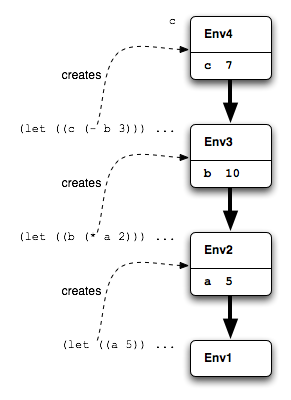Chapter 7. Another Variation on let
Suppose we have a fairly complicated calculation to make. We'd
like to compute intermediate values in order to simplify our code.
For example:
> (let ((a 5)
> (b (* a 2))
> (c (- b 3)))
> c)
Error: no binding for a in PScm::Env
It didn't work. The error occurs when attempting to evaluate
(* a 2). Why? Well in much the same way as let
fails for recursive definitions: because let binds its
arguments in parallel, at the point that it is trying to evaluate
(* a 2), it is still doing so in the environment prior
to binding a.
letrec can't help here, because it sets up an environment
with dummy values to evaluate its values in, which is OK if those
values are closures that just capture that environment for later,
but very bad if they're actually going to try to do any immediate
evaluations with those dummy values.
7.1. Sequential Binding
Of course the solution is quite simple even using our existing
let form: we just nest the let expressions
so that each value expression gets evaluated in an environment where
the previous value is already bound to its symbol:
> (let ((a 5))
> (let ((b (* a 2)))
> (let ((c (- b 3)))
> c)))
7
That would give us a set of environments as in Figure 18.
The outer let binds a to 5 to create Env2.
The next let evaluates (* a 2) in the context of
Env2 and creates Env3 with a binding of b to the result 10. The innermost
let evaluates (- b 3) in Env3 and binds
c to the result, creating Env4. In
Env4 the final evaluation of c results
in 7, which is the result of the expression.
While that works fine, it's rather ugly and verbose code. Wouldn't
it be better if there was a variant of let that did all
that for us, binding its variables sequentially? This variant of
let is called let* (let-star) and is found
in most lisp implementations.
7.2. let*
To implement let*, in the same way as we
implemented letrec, we create a new sub-class
of PScm::SpecialForm::Let and give it an Apply()
method, then bind a symbol (let*) to an instance of that
class in the initial environment. Our new class will be called
PScm::SpecialForm::LetStar and here's that Apply()
method.
50 package PScm::SpecialForm::LetStar;
51
52 use base qw(PScm::SpecialForm::Let);
53
54 sub Apply {
55 my ($self, $form, $env) = @_;
56
57 my ($ra_symbols, $ra_values, $body) = $self->UnPack($form);
58
59 return $body->Eval(
60 $env->ExtendIteratively($ra_symbols, $ra_values));
61 }
Again it only differs from the let and letrec
implementations of Apply() in the way it extends the environment
it passes to the Eval() of its body. In this case it calls the new
PScm::Env method ExtendIteratively().
39 sub ExtendIteratively {
40 my ($self, $ra_symbols, $ra_values) = @_;
41
42 my @symbols = @$ra_symbols;
43 my @values = @$ra_values;
44 my $newenv = $self;
45
46 while (@symbols) {
47 my $symbol = shift @symbols;
48 my $value = shift @values;
49 $newenv = $newenv->Extend([$symbol], [$value]);
50 }
51
52 return $newenv;
53 }
This method implements the algorithm we discussed earlier, creating
a new environment frame for each individual binding, and evaluating
the value part in the context of the previous environment frame.
The last environment frame, the head of the list of frames rooted
in the original environment, is returned by the method.
7.3. Summary
This may all seem a bit academic, but let's remember that Perl
supports both types of variable binding, let and
let*, in the following way.
Parallel assignment like let is done in a list context:
my ($a2, $b2) = ($a * $a, $b * $b);
Sequential binding like let* is done by sequential
assignment:
my $a = 5;
my $b = $a * 2;
my $c = $b - 3;
let has its uses, just as assignment in a list context
does. For instance with parallel assignment it becomes possible
to swap the values of variables without needing an additional
temporary variable. In Perl:
($b, $a) = ($a, $b);
...
and in PScheme:
(let ((a b)
(b a))
...)
Again, just for completeness, here's our 0.0.4 version of
ReadEvalPrint() with the additional let*
binding.
31 sub ReadEvalPrint {
32 my ($infh, $outfh) = @_;
33
34 $outfh ||= new FileHandle(">-");
35 my $reader = new PScm::Read($infh);
36 while (defined(my $expr = $reader->Read)) {
37 my $result = $expr->Eval(
38 new PScm::Env(
39 let => new PScm::SpecialForm::Let(),
40 '*' => new PScm::Primitive::Multiply(),
41 '-' => new PScm::Primitive::Subtract(),
42 if => new PScm::SpecialForm::If(),
43 lambda => new PScm::SpecialForm::Lambda(),
44 letrec => new PScm::SpecialForm::LetRec(),
45 'let*' => new PScm::SpecialForm::LetStar(),
46 )
47 );
48 $result->Print($outfh);
49 }
50 }
7.4. Tests
The additional tests for 0.0.4 are in
t/PScm_LetStar.t which you can see in
Listing 15.
Listing 15. t/PScm_LetStar.t 1 use strict;
2 use warnings;
3 use Test::More;
4 use lib 't/lib';
5 use PScm::Test tests => 3;
6
7 BEGIN { use_ok('PScm') }
8
9 eval_ok(<<EOF, '1', 'let binds in parallel');
10 (let ((a 1)
11 (b 2))
12 (let ((a b)
13 (b a))
14 b))
15 EOF
16
17 eval_ok(<<EOF, '2', 'let* binds sequentially');
18 (let ((a 1)
19 (b 2))
20 (let* ((a b)
21 (b a))
22 b))
23 EOF
24
The first test proves that ordinary let
binds in parallel, by doing the variable swapping trick. The second
test demonstrates let* binding
sequentially since the innermost binding of b to a sees the immediately
previous binding of a to the outer b.
Full source code for this version of the interpreter is available at
http://billhails.net/Book/releases/PScm-0.0.4.tgz
Last updated Tue Mar 18 21:59:29 2008 UST


